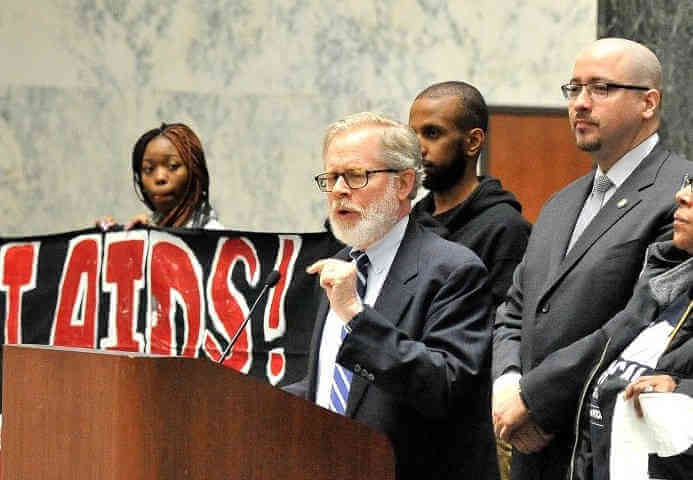New York State has aggressively embraced the Affordable Care Act, expanding Medicaid and offering health insurance plans for low-income residents, but inequality remains.
Where you live determines how long you live.
In Manhattan’s Upper West Side Community District 7, a resident’s life expectancy is 84.7 years while in Bedford-Stuyvesant, Brooklyn’s Community District 3, it is 76.8 years. Eleven percent of the adults in the Brooklyn district have no health insurance, while the comparable figure on the Upper West Side is five percent, according to the city health department’s 2018 Community Health Profiles.
For every 100,000 residents in Bedford-Stuyvesant, 55.1 contracted a new HIV infection in 2016, while on the Upper West Side the rate was 15.4.
For 31 years, Chelsea’s Richard Gottfried has been the chair of Assembly Health Committee, where he has pursued a Medicare for All/ single payer system for New York State and the nation as a whole. Last week, for the first time, he presented a proposal to cover all New Yorkers, the New York Health Act, at a time when his fellow Democrats control both houses of the Legislature.
This new bill is bigger than previous ones. It includes nursing homes providing long-term health care as well as home health care services. Advocates with high hopes wasted no time heralding the new measure as “the most comprehensive” statewide “universal health care bill” in the nation. The expanded services in the legislation, Gottfried said in a statement, provide “dignity and financial security to millions of aging and disabled New Yorkers.”
The supporters’ enthusiasm is understandable, and its passage is a possibility. Similar bills received Assembly approval four times. Eighty-one assemblymembers and 22 state senators are sponsoring this year’s bill.
Gottfried and his counterpart in the Senate, Gustavo Rivera of the Bronx, have promised to hold hearings after the budget is completed. Rivera, the lead Senate sponsor, said the bill helps those, especially women, “who are being suffocated by the financial burden placed on them as they provide long-term care.”
Hostility from the Trump administration won’t kill the bill. Gottfried, in an email, argued that federal cooperation is desirable but not required.
“It will be easier to run New York Health with federal waivers for Medicaid, Medicare, and the [Affordable Care Act],” he wrote. “But there are mechanisms that would enable NYH to incorporate or wrap around those programs so we can continue to draw down the federal funding and still have the system operate as a single-payer system.”
The bill’s language establishes health care as a right: “Every resident of the state shall be eligible. No individual shall be required to pay any premium or other charge.”
The legislation protects New York employers and employees who routinely see their costs jump when insurance companies hike their rates. The current system of co-pays often means that sick people see their costs spike at the very time their income is constrained by illness.
The new system provides for a graduated tax on income that exempts the first $25,000 from taxation. The revenue would come from two taxes: “a graduated tax on all payroll and self-employed income” and a non-payroll tax on other income such as “interest, dividends, and capital gains,” also pegged to income level. A person whose income drops due to illness would see their medical taxes decline.
For many employer health plans as well as self-employed individuals, the tax would be lower that the current premiums for gold-plated coverage, according to a study by the RAND Corporation. An overriding objective of the new system is to get medical costs under control. One method is stopping insurance companies and drug companies from using their market power to increase costs borne by consumers and employer health plan subsidies. The bill explicitly states that its objective is to inhibit “rising premiums, deductibles, and co-pays, and high out-of-network charges.” The legislation does away with provider networks by offering every New Yorker the opportunity to see the doctor of their choice.
The bill’s language explicitly offers protection from the growing problem of employers “shifting a larger share of the cost of coverage to their employees or dropping coverage entirely.”
In Europe, medical costs are a smaller proportion of the national income than in the US but government health care systems there provide citizens better coverage. In the language of Gottfried’s bill, its long-term objective is “movement away from fee-for-service payment, which tends to reward quantity and requires excessive administrative expense, and towards alternate payment methodologies, such as global or capitated [per patient] payments.” This, in turn, provides incentives for health care providers to encourage preventive medicine, a key principle in Canadian and European health care systems.
The Campaign for New York Health coalition includes 1199 SEIU, the national health care workers’ union. Gabby Seay, the group’s political action director, said provisions guaranteeing long-term care meet the new reality of needs facing “our aging population.”
The State Nurses Association supports the Gottfried measure because “many of our insured patients are struggling to afford the co-pays, deductibles, and out-of-network charges,” said Marva Wade, a board member at the group.
NYC Health + Hospitals, which maintains the city’s public hospitals, clinics, and long-term care facilities, has also endorsed the bill. Dr. Mitchell Katz, the agency’s CEO, said, “It will decrease needless administrative costs” and “allow us to invest more” in meeting the health needs of their patients.
Wendy Stark, executive director of the Callen-Lorde Community Health Center, which provides specialized care to the LGBTQ community, also backs the measure, explaining that it provides “a much needed reset to our state’s fragmented health care system.”
The legislation would create a board within the State Health Department to advise the commissioner on the scope of the new programs and to involve stakeholders in the creation of the New York Health system. The governor would appoint 26 members from groups including medical specialties and care advocates. An additional 14 members would be appointed by legislative leaders. That board, in turn, would make recommendations to the state health commissioner.
According to the bill’s supporters, while Governor Andrew Cuomo supports a single payer system for the nation, he has not yet shown his cards on moving forward in New York State alone.



































